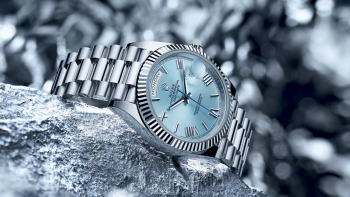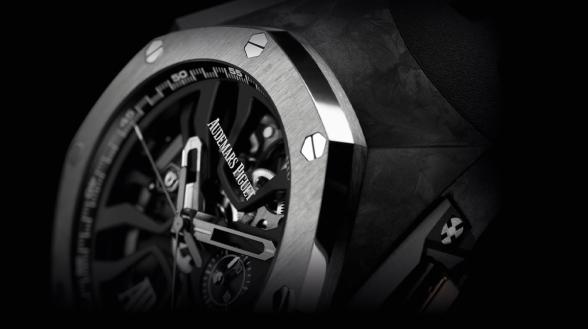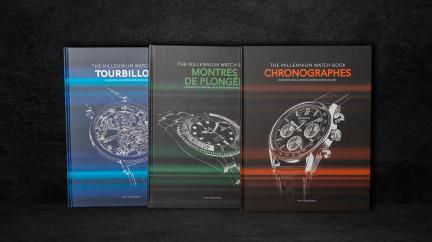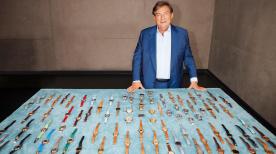Rolex
Among the Patek Philippes, the Vacheron Constantins, the Girard-Perregauxs and the Audemars Piguets, there are a couple of top luxury watch brands that stand out because they are not named after a duo of founding partners: Omega and Rolex. Both were the brainchild of just one man and both were given short, snappy names. But while Omega was named after one of its most legendary watch movements, the name Rolex came seemingly out of nowhere, as the company’s founder Hans Wilsdorf claimed that a genie had whispered it to him while he was on the top deck of a horse-drawn omnibus in London in 1908.
From there it was post haste to the nearest trademark office, where he proudly recorded that he had coined the word himself for his watches. What distinguishes Rolex from other watch brands, still today, is that its name is short (just five letters), easy to pronounce in most languages and fits perfectly on a watch dial and movement.
Remarkably, Hans Wilsdorf was based in London and was in fact in a partnership with his brother-in-law Alfred Davis. Until the name Rolex appeared from nowhere, the company was just another one of those double-surname concoctions, with “Wilsdorf and Davis” not quite having the same ring as its peers. The fully integrated Swiss manufacture would not come until much later, as the founders were German and British respectively and ordered their movements from Aegler, a company based in Bienne, Switzerland. In fact, despite a very close working relationship, including an agreement of mutual exclusivity under which Aegler only sold movement to Rolex and Rolex only bought its movements from Aegler (except for the chronograph movements in the Daytona), the true vertical integration only occurred on 26th March 2004, when Aegler was finally sold to Rolex.
Since the very beginnings, Hans Wilsdorf was interested in precision. At a time when wristwatches were still relatively new and people still had their doubts about whether these smaller watches could rival the solidity, reliability and precision of pocket watches, Hans Wilsdorf was keen to prove that they could. In fact, a Rolex wristwatch was the first watch in the world to be awarded a certificate of precision by the predecessor of today’s COSC, the official watch rating centre in Bienne. That was in 1910, laying the foundations for a brand that would come to be recognised for the superlative quality and performance of its watches.
It all started with an Oyster
Rolex set up a permanent base in Geneva in 1919 and the famous five-pointed crown was added in 1931. Ever since, it has been inextricably linked with the name and stands as a symbol of the brand’s precision, visible on the dial of every Rolex watch. The knack for finding snappy names with universal appeal continued with the Rolex Oyster, which was presented in 1926. Hans Wilsdorf had not only foreseen the dominance of the wristwatch, he had also foreseen that post-war generations would be more adventurous, because the Rolex Oyster was the world’s first waterproof watch and thus aptly named. What’s more it was brought to fame by a woman, British swimmer Mercedes Gleitze, who was the first to swim the English Channel. She did so wearing a steel Rolex Oyster and is thus widely recognised as one of the first sporting ambassadors for a watch brand. Its signature fluted bezel in steel was functional, since it was screwed on to the case middle with a special tool developed by Rolex. Although the modern steel Rolex watch cases are no longer assembled in this way, the classic Rolex Datejust watches still have this fluted bezel.
The Oyster heralded the birth of the “tool watch” and Rolex provided mountaineers and diving expeditions with the watch to continue to test it in real-world conditions. This allowed the development of an entire range of professional watches, leading to Oyster Perpetual models like the Explorer, Cosmograph Daytona, Submariner and Sea-Dweller.
The company’s first automatic watch, the Rolex Oyster Perpetual, followed in 1931. Again, what better name could there be for a watch that would continue to function as long as it was being worn and its wearer’s movements would keep the winding rotor moving to wind the watch up? The word perpetual has since outgrown the name of the winding rotor to become a guiding philosophy for the brand as a whole, embodied in the expression “Perpetual Spirit”. Paradoxically, the one perpetual thing that Rolex has never produced is a perpetual calendar!
The launch of the Rolex Datejust in 1944 coincided with the death of Hans Wilsdorf’s wife Florence. A widower without descendants, he set about securing the long-term future of Rolex by creating the Hans Wilsdorf foundation (which is registered as a charitable organisation) and transferring all Rolex shares to this foundation with instructions on how to manage the company. Not only did this decision have a profound impact on the company, it also achieved its objective. In taking it, Hans Wilsdorf probably couldn’t imagine its significance as Rolex became a dominant force in luxury watchmaking and grows ever stronger as the years pass. Freed from the constraints of family ownership or shareholders, or the need to disclose figures, Rolex has always been able to set itself apart from its peers.
The Oyster Perpetual Datejust was the first self-winding wrist chronometer to show the date in a window on the dial. It just goes to show that it is the small details that matter most, with the watch still using the same classic design over half a century later, including the fluted bezel and the now legendary Jubilee band. The Oyster Perpetual Datejust was originally designed for men, but a number of women’s models quickly followed.
A decade after the Oyster Perpetual Datejust came the Oyster Perpetual Day-Date, signalling yet another first: the first wristwatch to display the day of the week written out in full on the dial, as well as the date. At first it was only available in luxury versions with cases in 18-carat gold or platinum, and introduced the now-famous Cyclops magnifying lens for improved legibility of the date on the dial, which was subsequently extended to all Rolex watch collections.
Over 70 years after it was first introduced, the Datejust remains one of the cornerstones of the Rolex collection. Although it has always retained its signature design, including the Jubilee and President bracelets, the fluted bezel and the Cyclops date window, the Datejust is today available in a huge variety of models, from the Datejust 41mm for men to the 28mm Lady Datejust, as well as in intermediate sizes of 31mm, 34mm and 36mm. This variety in size alone means that there is the perfect Datejust for any man or woman. Beyond this, the Datejust is available in many different case designs, from full stainless steel to all gold with two-tone versions in Rolesor also available, in yellow or Everose gold.
The Datejust 41 is equipped with a new-generation movement, calibre 3235, entirely developed and manufactured by Rolex for a superlative level of performance.
The rise of the professional watch
Although Rolex is most famous for accompanying Sir Edmund Hillary on his ascent of Everest, the brand had already been involved in expeditions to the world’s tallest peak for 20 years before this milestone achievement. Hans Wilsdorf had been spot-on with his belief that people would have more free time and thus more time for ever more adventurous pursuits. Rolex had equipped the men of the Houston-Everest Expedition with Oyster watches in 1933. This was the first flight over Everest at altitudes exceeding 10,000 metres (33,000 feet). In the same year Rolex equipped a British Everest expedition led by Hugh Ruttledge. His men reached 8,580 metres but were forced to turn back due to bad weather. Everest would remain the holy grail of mountaineering for the next 20 years until Hillary and Norgay achieved the ultimate goal and stood on top of the world in 1953.
The experience helped Rolex to develop watches for high-altitude mountaineering that could resist extreme temperatures. As a tribute to Hillary’s achievement, Rolex launched the Explorer and later improved it with a reinforced case and a more legible dial. Like most Rolex watches, the Explorer has evolved over the years while remaining instantly recognizable. The Explorer II was presented in 1971, complete with a date display, an additional 24-hour hand on the dial and a fixed bezel with 24-hour graduations. Before GMT watches became popular, the Explorer II introduced the 24-hour scale to assist explorers in caves and polar regions, where it can often be difficult to distinguish between day and night. It’s not surprising, therefore, that the Explorer II became the preferred watch of speleologists, volcanologists and polar explorers.
In 1953, Rolex presented the Submariner, which was the first wristwatch waterproof to a depth of 100 metres. In 1960 an experimental Submariner model called the Deep Sea Special was fitted to the exterior of the submersible piloted by Swiss adventurer Jacques Piccard and Don Walsh. This Submariner watch withstood immense pressure at a record-breaking depth of 10,916 metres – a feat that went unmatched until 52 years later, when James Cameron also reached the bottom of the Mariana Trench. Naturally, Cameron was also accompanied by an experimental Rolex Submariner, the Rolex Deepsea Challenge, which was engineered specifically for this expedition to withstand the huge pressures. While the Submariner has evolved over the past half a century, it, too, remains faithful to the original. The Submariner is designed with divers in mind and therefore features a clear dial with large luminescent hour markers and a unidirectional bezel. It is available in the Submariner and Submariner Date versions.<
The age of travel and the birth of the GMT Master
The first true Rolex GMT watch came in 1955 with the Oyster Perpetual GMT Master in steel, which incorporated an additional 24-hour hand on the dial to show a second time zone and a rotating graduated 24-hour bezel. At the dawn of the age of travel by aeroplane, the GMT Master became the official watch of the young Pan American World Airways.
Rolex and CERN – the birth of the Rolex Milgauss
You are probably familiar with the work of CERN today thanks to the large hadron collider (LHC) that runs in a cross-border ring around the outskirts of Geneva and through France, or possibly because of its claim to fame as the place where the world wide web was invented. But Rolex’s association with the European particle physics laboratory dates back to the 1950s. At the time, the engineers working at the laboratory noticed that the magnetic waves were affecting the operation of their mechanical watches. Rolex found the solution to the problem with the Milgauss, which was launched in 1956 with a steel case that could withstand magnetic interference up to 1,000 gauss thanks to a patented magnetic shield. Rolex continues its association with CERN today, sponsoring the organisation’s permanent exhibition Universe of Particles at the Globe of Science and Innovation – the distinctive building that marks the organisation’s above-ground presence.
Cosmograph Daytona – an icon is born
It was in 1963 that Rolex introduced its Cosmograph Daytona. The chronograph function, on the dial combined with a tachymeter, allows the calculation of elapsed times and average speeds. The Daytona has become one of the most sought-after Rolex models among collectors, with the Daytona owned by Paul Newman establishing a record as the most expensive watch ever sold at auction.
Rolex Oyster Perpetual Sea Dweller – the watch for professional divers
Rolex introduced the steel Oyster Perpetual Sea Dweller in 1967. It was not the first-ever diver’s watch but it was resistant to 600 metres (2,000 feet) and featured a patented helium escape valve that could be used to release pressure from inside the watch during a professional diver’s decompression phases in hyperbaric chambers.
Cellini and the classic touch
Rolex presented the Cellini collection in 1968, introducing the first watches with a new case that was different from the Oyster construction. The Cellini, named after Italian Renaissance artist Benvenuto Cellini, became Rolex’s dress watch collection with a classic design.
Second-generation professional watches
After helping with the development of the first Swiss quartz movement in the late 1960s, Rolex launched its own Oysterquartz movement in 1977 but later made the strategic decision to produce only self-winding mechanical watches. The 1970s and 1980 thus saw the arrival of a second generation of Oyster Professional watches. The Oyster Perpetual Explorer II came in 1971, followed by a new Sea Dweller in 1978, which was water resistant to 1,220 metres (4,000 feet). The second iteration of the GMT Master, the GMT Master II, came in 1982.
A watch for the yachtsman; and one for women
In 1992 Rolex presented the Oyster Perpetual Yacht Master, with a special regatta countdown timer function. In the same year the brand also presented the Oyster Perpetual Pearlmaster – a watch designed specifically for women. The Pearlmaster combines precious metals like gold with gemstones such as the diamond for the ultimate touch of refinement. The Pearlmaster’s lines are curved and the band is either with links in full metal or diamond set metal. Diamond set bezels are also available, as is a fully diamond set dial. The quality of each diamond is checked and approved by Rolex’s own internal gemmology laboratory. Rolex allows you to configure your own Pearlmaster on their website, leaving you the option to have as much diamond as you want. Naturally, the price for such extravagances is only available on request.
Vertical integration and a new era for the Oyster
Another significant strategic decision in the 1990s laid the foundations for Rolex’s future. Long before the rush to “manufacture” status by other brands who found themselves suddenly abandoned by ETA, the industry’s biggest movement supplier, Rolex opted for vertical integration. The company started buying up its suppliers and centred its activities on four sites in Geneva and Bienne. The reorganisation brought new impetus into the Oyster case watches, leading to a new Oyster Perpetual Cosmograph Daytona in 2000, which had a brand-new movement equipped with a Parachrom hairspring.
A redesigned Oyster Perpetual GMT Master II came in 2005, also with the new Parachrom hairspring and a new bezel with a black Cerachrom insert, also developed and manufactured in-house by rolex. A new Oyster Perpetual Milgauss followed in 2007 with the Parachrom hairspring and a new paramagnetic escape wheel made of a nickel-phosphorous allow. In the same year a second iteration of the Yacht Master, the Yacht Master II was introduced, with a programmable countdown with mechanical memory, operated by the Ring Command bezel.
Rolex reaffirmed its supremacy in diver’s watches in 2008 with the launch of the Oyster Perpetual Rolex Deepsea, which was water resistant to 3,900 metres (12,800 feet), using Rolex’s Ringlock System, which features a compression ring inside the watch to withstand the extreme pressure exerted on the crystal and case back at such depths.
Rolex put its Ring Command bezel to a new use in the Oyster Perpetual Sky-Dweller, launched in 2012. The watch has a GMT function as well as an annual calendar display that is operated by the Ring Command bezel.
A master of materials
Rolex uses a proprietary steel, called Oystersteel, which is produced entirely in-house and belongs to the 904L family of steel, rather than the 316L steel more commonly used for watches. 904L steel is used in high-tech applications because of its superlative anti-corrosion properties.
Rolex also controls the entire process for the manufacture of gold Rolex cases. The 18-carat alloys used include yellow and white gold as well as Everose, Rolex’s exclusive rose-gold alloy.
The name Rolesor, used for the two-tone designs that feature steel and gold, was first patented by Rolex in 1933, and comprises combinations of yellow gold or Everose gold with Oystersteel. Note that on white Rolesor models, the bezel alone is in 18-carat white gold.
At the top of the range are luxury Rolex watches in platinum with its unique sheen, as well as gem-set models featuring the sparkle of the diamond.
For the bezels on its professional models, Rolex developed and patented Cerachrom using a hard ceramic with gold or platinum infilled for the graduations.
Only for sale in a shop
Rolex’s traditional and independent approach extends to its distribution. Although many import retail locations have their own “monobrand” Rolex shop, these are always operated in collaboration with experienced authorised Rolex dealers. And you will only find new Rolexes for sale in these authorised retailers. Rolex has also resisted the temptation of e-commerce, and continues to ensure its watches are sold only by authorised dealers. Rolex, was, however, one of the first brands to understand the importance of communicating the retail price of its watches on its website. On the one hand, hiding the retail price beneath an extra click kept visitors on the official website, on the other, indicating the official retail price of watches gives customers a benchmark to help them navigate the complex world of Rolex prices.


















